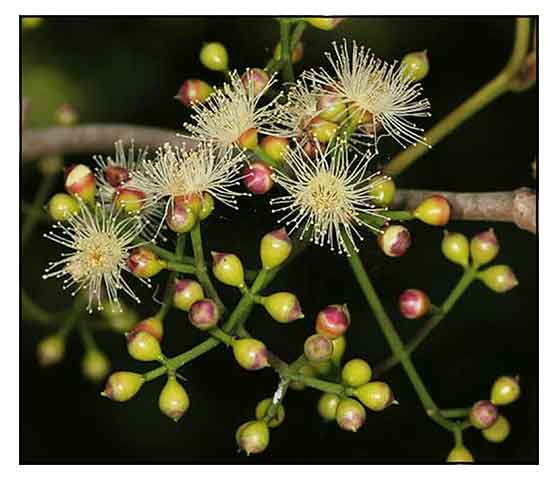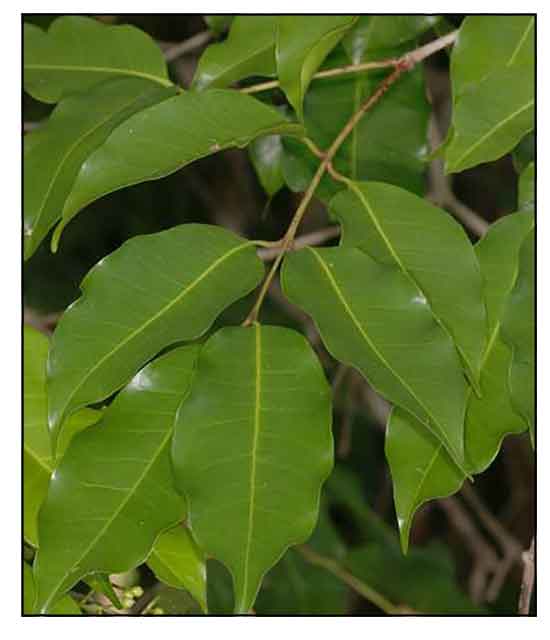Gen info
- Syzygium is a genus of flowering plants in the myrtle family Myrtaceae, comprising about 1200 species, with a native range extending from Africa and Madagascar through southern Asia through the Pacific. (15)
- Syzygium nervosum was previously known as Cleistocalyx operculatus.
- Etymology: The genus name Syzygium derives from Latin syzygia, meaning "joining together or conjunction". (14)
 Botany Botany
• Syzygium nervosum is a medium-sized to fairly large tree up to 40 m tall, bole up to 80 cm in diameter, with sharp buttresses up to 2.5 m high, bark surface smooth to scaly or flaky, greyish-brown; leaves elliptical-oblong to elliptical-lanceolate, (6-)8-22 cm × 3-7 cm, with 7-15 pairs of secondary veins distinct below, petiole up to 15 mm long; flowers in lateral many-flowered, paniculate inflorescence on twigs below the leaves, calyx calyptriform, the upper part falling as a lid; fruit ellipsoid to globose, c. 1 cm long, red, purplish or black when ripe. (2)
• Trees, to 15 m tall, many-branched. Bark grayish brown, thick. Branchlets flattened, furrowed. Petiole 1-2 cm; leaf blade oblong to elliptic, 11-17 × 4.5-7 cm, thinly leathery, both surfaces glandular punctate, secondary veins 9-13 on each side of midvein, 8-9 mm apart, and at an angle of 45°-60° from midvein, reticulate veins obvious, intramarginal veins ca. 2 mm from margin, base broadly cuneate to slightly rounded, apex acute to acuminate. Inflorescences lateral on leafless branches, paniculate, 6-12 cm. Buds oval, ca. 5 × 3.5 mm. Hypanthium hemispheric, ca. 3 mm, not stipitate. Calyptra 2-3 mm, apex beaked. Petals obsolete. Stamens 5-8 mm. Style 3-5 mm. Fruit violet to black when mature, broadly ovoid, 1-1.2 × 1-1.4 cm. (Flora of China)
Distribution
- Native to the Philippines.
- Also native to Assam, Australia, Bangladesh, Borneo, Cambodia, China, Christmas I., Hainan, Himalaya, India, Jawa, Lesser Sunda Is., Malaya, Maluku, Myanmar, Nepal, Northern Territory,, Sri Lanka, Sumatera, Thailand, Tibet, Vietnam. (1)
- In forests up to 1500 m altitude, usually at the margins of freshwater swamps and near streams. (2)
 Constituents Constituents
- Phytochemical studies have revealed triterpenoids, flavonoids, and phloroglucinols are the main components of S. nervosum. (3)
- Study quantified ten phenolic acids and flavonoids
i.e., gallic acid, chlorogenic acid, caffeic acid, p-coumaric acid, ferulic acid, HBA, salicylic acid, cinnamic acid, rutin, and quercetin. The methanolic and ethanolic extract contained all the compounds, while the ethyl acetate extract lacked the presence of caffeic acid and ferulic acids. Chlorogenic acid in the ME (6.89 mg/g) was 10-30 times higher than EA and ET. Other phenolic acids were in the order of ME > ET > EA. (see study below) (5)
- Study of leaves isolated 13 new pentacyclic triterpenoids, cleistocalyxic acids A-K (1,2,4,5 and 7-13) and cleistocalyxolides A and B ( 3,6) and 15 known analogues. (see study below) (11)
- Study of aqueous and ethanol extracts of leaves yielded total phenolic content of 88.1 and 58.6 mg/g GAE, respectively. (12)
- Study of dichloromethane extract of seeds isolated two flavonoids, viz. 2',4'-dihydroxy-6'-methoxy-3',5'-dimethylchalcone (DMC) and hariganetin. (see study below) (13)
Properties
- Studies have suggested anticancer, antigout, antioxidant, antidiabetic, anti-inflammatory properties.
Parts used
Leaves, bark, flowers.
Uses
Edibility
- Fruit is edible.
- In Indo-China, leaves used for making tea.
- Among Vietnamese and Chinese communities, decoction of S. nervosum leaves and flower buds consumed regularly as beverage..
- Leaves used as spice.
Folkloric
- In Vietnam, leaves and flower buds used for influenza, skin diseases, digestive conditions, diarrhea, and abdominal pain. Used externally for inflammatory conditions, bruises, acne, and skin ulcers. (3) Herbal tea of leaves and buds used for stomachic properties.
- In Chinese folk medicine, leaves and bark used externally to treat skin ulcers and scabies; internally, leaf extracts used for treatment of diarrhea, pimples, breast inflammation. Water extract of flowers used for treatment of influenza, dysentery, and indigestion; roots used for jaundice and abdominal pain. (3)
Others
- Wood: The wood is grayish-yellow; the density is 680-850 kg/m3at 15% moisture content.
Studies
• DMC / Cytotoxicity against Various Cancer Cell Lines: Studies on the cytotoxicity of DMC ( 2′, 4′-dihydroxy-6′-methoxy-3′, 5′-dimethylchalcone), the major chalcone isolated from S. nervosum showed varying magnitude of cytotoxicity against various cancer cell lines. The chalcone exhibited strongest cytotoxicity against A549 cells with IC50 of 2.3 µM. It was also very active against a variety of cancer cell lines with IC50s ranging from 8 to 15 µM, such as HepG2, ASK, P-388, and PANC-1. (3)
• Effect of Processing Methods on Herbal Tea Leaf: Study evaluated the effect of various thermal treatments like blanching, convective drying, roasting, and steeping to the anti-nutritional factors, phenolics, and antioxidant capacities in S. nervosum dried leaf tea. Results show that S. nervosum leaves should be blanched at 90/15°C/s, convective drying at 55/14°C/hrs, roasting 140/4°/C/mins, steeping in hot water at 80/4°C/mins to removed anti-nutrients while preserving phenolics and antioxidants in the dried leaf tea. (4)
• Antidiabetic / Antigout / Anti-Inflammatory / Radical Scavenging: Study evaluated the phenolics, antioxidant potential, anti-inflammatory, antigout, and antidiabetic properties of various leaf extracts of S. nervosum. The methanolic extract contained significantly higher levels of phenolics compared to other extracts, and exhibited most potent DPPH radical scavenging activity (IC50 = 11.76 µg/ml), comparable to ascorbic acid. The ME also exhibited strongest inhibitory effects on α-glucosidase and bovine albumin denaturation with IC50s averaging 27.66 and 156.55 µg/mL, respectively. The ethyl acetate and ethanolic extracts showed antigout potential with higher inhibitory activity to xanthine oxidase. (see constituents above) (5)
• DMC / Anticancer / Human Cervical Cancer Cell Line / Seeds: Study evaluated DMC for inhibitory activities against various cancer cell lines viz., C-33A, HeLa, and SiHa. DMC exhibited antiproliferative cervical cancer activity in all three cell lines with IC50s of 15.76, 10.05, and 18.31 µM, respectively. DCM exhibited higher antiproliferative cancer activity in HeLa cells. On further studies on HeLa cell line, DMC showed increased DNA damage in cancer cells. Cell cycle assay showed increased number of cells in G0/G1 phase following DMC treatment. DMC treatment-induced apoptosis was 3 to 4-fold higher. Results suggest potential of DMC for antiproliferative cervical cancer drug development. (6)
• Microwave Assisted Extraction of DMC / Fruits: Study evaluated the microwave assisted extraction(MAE) to recover DMC-rich extract from Syzygium nervosum fruit, reporting on optimal conditions and settings i.e., microwave power and time. The DMC-rich extract obtained from MAC showed stronger anticancer activities against A549 (human lung cancer cells) and HepG2 (human liver cancer cells) than individual DMC substance. Results suggest MAE is an effective method for extracting essential phytochemicals from plants in nature. (7)
• Silver Nanoparticles / Catalytic, Antibacterial, Antifungal / Buds: Study reports on the biosynthesis of stable silver nanoparticles (BioAgNPs) using aqueous extract of buds of S. nervosum as both reducing and stabilizing agent. Good antibacterial activity was demonstrated by colloidal BioAgNPs against four bacterial strains viz., Gram-positive S. aureus and B. subtilis and Gram-negative E. coli and S. typhi, with greater activity at low doses against Gram-negative S. typhi. The NPs displayed significant catalytic activity. The BioAgNP formulations significantly suppressed Colletotrichum camelliae (anthracnose disease) without affecting the growth of tea plants. (8)
• Neuroprotective / Antioxidant / Fruit: Study evaluated the neuroprotective effect of Cleistocalyx nervosum var. paniala (CNP) extract against glutamate-mediated oxidative/ER stress-induced cell death in mouse hippocampal neuronal HT22 cells. Pretreated cells prevented neuronal death in response to 5mM glutamate. CNP extract inhibited ROS (reactive oxygen species) production and suppressed specific-ER stress apoptotic protein levels in glutamate-induced cells by upregulating gene expression of cellular antioxidant enzymes (SODs, CAT, GPx, and GSTs). Results suggest a promising antioxidant and neuroprotectant. (10)
• Cytotoxicity Triterpenoids / Anticancer / Leaves: Study of leaves isolated 13 new pentacyclic triterpenoids, cleistocalyxic acids A-K (1,2,4,5 and 7-13) and cleistocalyxolides A and B ( 3,6) and 15 known analogues. Cleistocalyxic acid B (2) displayed cytotoxicity against Hep^2, NCI-N87, and MCF-7 cancer cell lines with IC50 ranging from 3.2 to 6.5 µM. Cleistocalyxic acid D (5) was active against HepG2 and NCI-N87 with IC50 around 5.0 µM. Noncytotoxic cleistocalyxic acid E (7) inhibited production of IL-6 buy 68.1% and TNF-α by 53.7% in LP-induced RAW 264.7 macrophages at concentration of 2 µM. (11)
• Antioxidant / Leaves: Study evaluated the antioxidant capacity of aqueous and ethanol extracts of Eugenia operculata leaves using DPPH and reducing power method. By DPPH assay, IC50s for ethanol and aqueous extracts were 52.96 and 41.73. Reducing assay showed dose dependent reducing power. The extract showed potent antioxidant activity when compared with standard ascorbic acid and gallic acid. Total phenolic content if aqueous and ethanol extracts were 88.1 and 58.6 mg/g GAE. (12)
• Anti HIV-1 Reverse Transcriptase / DMC / Seed: Study of dichloromethane extract of seeds of Syzygium nervosum isolated two flavonoids, viz. 2',4'-dihydroxy-6'-methoxy-3',5'-dimethylchalcone (DMC) and hariganetin. Both DMC and hariganetin showed moderate activities against HIV-1 reverse transcriptase with 67.5% and 64.1% inhibition, respectively. (13)
Availability
Wild-crafted.
Tea, supplements in the cybermarket.
|

![]()





